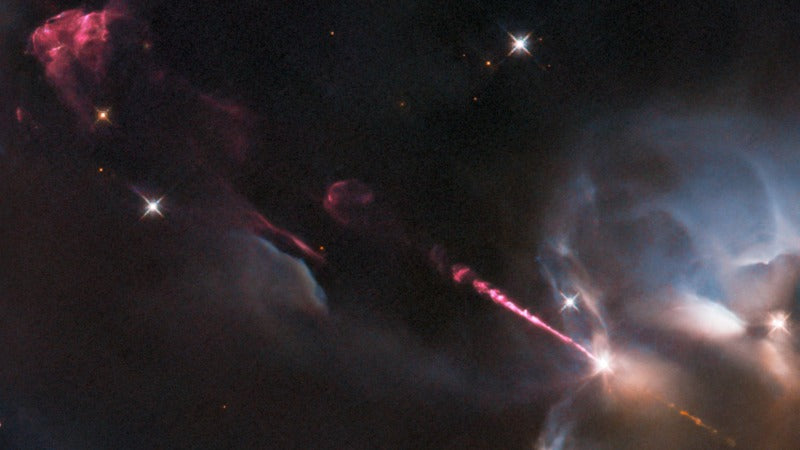
Breathtaking Baby Star "Tantrum" Captured by Hubble
Share
Hubble captured an epic outburst from a baby star still in the process of forming.
Nearly 1,250 light-years from Earth, in the Orion molecular cloud star-forming region, supersonic jets are hitting the gas at supersonic speeds, causing it to glow brightly. As a result of this cosmic interaction, a short-lived, beautiful, and luminous structure is formed called a Herbig-Haro object.
This particular Herbig-Haro object is known as HH 34 and is considered one of the most spectacular phenomena in the Milky Way. It is, however, much more than that. As these outbursts change over the course of Earth years, they can provide clues as to how baby stars are born.

Baby star outburst HH 34. (ESA/Hubble & NASA, B. Nisini)
It is necessary for a Herbig-Haro object to form under specific conditions. The process begins with a baby star, known as a protostar. Protostars are formed from dense clumps of gas and dust in a molecular cloud that collapses under their own gravity. The protostars spin in this celestial cradle and begin to accrete matter from the cloud around them as they spin.
The protostar is capable of ejecting powerful plasma jets from its poles during this process. It is believed that some of the material that is swirling around the protostar is funnelled along its magnetic field lines.
The magnetic field lines accelerate the particles so that when they reach the poles, they are launched at high speeds into space as very tightly collimated jets. Ionization of the material occurs as a result of the insane temperatures involved.

Earlier Hubble images of HH 34. (NASA, ESA, and P. Hartigan/Rice University)
As Herbig-Haro objects, these jets slam into the surrounding molecular cloud at hundreds of kilometres per hour. At these locations, hot temperatures cause the material to glow brightly.
In this way, we are able to observe and track the jets more easily. Protostars produce powerful stellar winds as they grow. The wind and jets are combined to form protostellar feedback, which is crucial for the evolution of the star.
This occurs because they blow away the material around the star, which is thought to halt its growth. In other words, protostellar feedback has a direct impact on the final mass of a fully developed star.
HH 34 is particularly interesting due to the multiple bow shocks defining the extent of the jets. It has been imaged several times by the Hubble Space Telescope, including in 1994, 1998, 2007 and again in 2015. This is the latest image to be captured.
Because of how rapidly Herbig-Haro objects evolve, scientists can track the changes in the series and observe how the jet expands over time. This can also help map the cloud around the young protostar.
The recently launched James Webb Space Telescope will revolutionize our understanding of these jets. The infrared capability will allow it to peer into the densely dusty region around a protostar to shed more light on how these jets are launched.
You can download the above images in wallpaper sizes from the ESA Hubble website.




